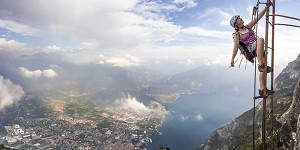
In this regular feature from the British Mountain Guides , Tainia Noakes takes us on a Dolomites ridge adventure.
The rock on both climbs is generally excellent, the best that I have ever encountered in the Dolomites. It is a world of incredibly featured rock, pale and steep, brimming with holds even on the most intimidating and exposed faces. It's an area that will doubtlessly lure you back again and again. Even if you have been put off climbing in the dolomites in the past because of dubious rock quality and meandering, difficult to follow route descriptions you should consider giving this area and guidebook another chance.

Pala del Rifugio 2394m North-west ridge (Castiglioni/Detassis) linked with the Sasso d'Ortigo 2631m West Ridge (Spigolo Weissner-Kees).
Range
The Pala di San Martino, Dolomites, North-east Italy.

Mountain
Pala del Rifugio 2394m followed by the Sasso d'Ortigo 2631m.
Length
820m for the Pala del Rifugio (18 pitches 6-7hrs) and 500m (10 pitches 4-5hrs) for the West ridge of Sasso d'Ortigo. The two routes can be linked together with 45min of easy but serious scrambling along the ridge which joins the two summits together. Making over 1300m of climbing if both routes are linked in a day!
Grade
TD- max 5 for the Via Castiglioni-Detassis.
D+ max 5 with short section of 5+ for the Weissner-Kees. (Mostly HS-VS climbing with a few HVS pitches)
Route Summary
NW Ridge of the Pala del Refugio: This route deserves its status as one of the most highly prized in Val Canali. It consists of about 18 pitches of thoroughly enjoyable climbing. The rock is excellent with plenty of opportunities for placing protection. The situation is particularly fine with exceptional views from high on the route. There are plenty of memorable pitches too, particularly in the chimney corner system before the first shoulder and in the upper sections which are both exposed and dramatic. However the descent should not be taken lightly and is perhaps the part of the route that requires the most concentration.
West Ridge of the Sasso d'Ortiga.
This is a magnificent classic on an elegant and unlikely line at its grade. The rock it unusually solid and there are an incredible abundance of huge holds and natural threads. It quite simply is one of the best climbs I have ever done at this grade. The route has breath-taking exposure in parts without feeling too serious but it can be steep and tiring. There are about 10 pitches with the crux saved for towards the end of the climb. You must step off an enormous chock-stone and pull onto the face of the final tower. Here a few more of those enormous holds would not go amiss. But don't worry... you can pull through on pegs if your arms are beginning to tire!

Approach: NW Ridge Pala del Refugio.
From Refuge Treviso walk on footpath 707 for about 20minutes. Through a wood and then up the side of a stream bed to the rocks at the base of the NW ridge. From here you scramble through a short rock band followed by about 100m of steep grassy rock to the start of the climb. The whole approach is about 45min.
Approach: W Ridge Sasso d'Ortiga
To approach directly from Refuge Treviso simply reverse the descent description from the Pala del Refugio to the notch below the West ridge.
Descent: Pala del Refugio 2394m
This descent is long and relatively serious, especially when wet and this should be taken into account before committing to the route. It is, however, clearly marked by red paint and protected in places by well positioned bolts. A full detailed description is contained in the guide book recommended below. This is adventure climbing at its best! From the summit rocks of the Pala del Refugio essentially you follow the rocky spine that links it to the base of Sasso d'Ortigo. Scrambling first on the right side of the crest before crossing onto the more vertiginous left side. Finally you pass through a notch on the ridge that allows access back to the other side. If you plan to link the two climbs at this point you are at the start of the West ridge and should launch yourself skyward with energy and haste. For those who find themselves running short of energy or time (or both) the Sasso d'Ortiga can be saved for another day. If renouncing the second climb then you descend a gully that turns into an exposed ledge system leading beneath the SW face of the Sasso D'Oritga towards the Fuorcla del Mughe. Cables and bolts protect the most exposed sections. From the summit to FdM takes about 1hr 30min in dry conditions. A further 1hr of quite steep footpath (number 720) returns you to Refuge Treviso... including some exciting vertical tree root swinging on the path itself!
Descent from the Sasso d'Ortiga 2631m.
From the summit you go down south-east along a rocky spine marked by cairns and red paint flashes. Mostly walking with a little scrambling and one final abseil of 20ms to reach the Fuorcla del Mughe (previously mentioned). 1hr from the summit.
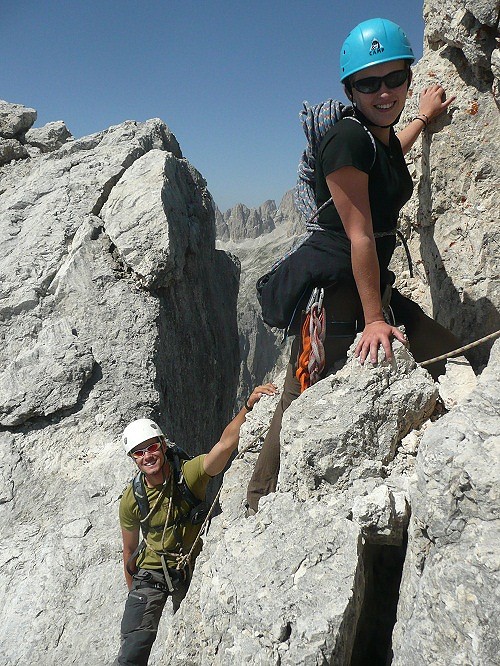
Best Tactic for an Ascent
A fast and experienced team will enjoy the challenge of linking these two amazing route in one long day. For a more leisurely (but still pretty full!) couple of days it would be wise to do them separately. The approach for the Sasso D'Ortiga is part of the descent from the Pala del Refugio. Climbing these routes on consecutive days means you gain useful knowledge of the approach the next day. Of course it also means that you know how long it is...

Logistics
When to Go
The best time of year for climbing is from late June through September. August is normally fairly busy but in this quiet climbing mecca that shouldn't really be a problem. The dolomites have a well-deserved reputation for fierce afternoon thunderstorms that pose problems when considering committing routes. This could be critical on the Pala del Refugio with its serious descent. It is best to ensure that there is a low risk of thunderstorms when undertaking this challenge. Sometimes the slightly cooler September air reduces the risk of thunderstorms in the Dolomites. That said last August I spent two weeks here with cold, clear and thunderstorm free weather. Perfect for any length route... sometimes I guess you're just lucky.
Accommodation Advertise here
No Premier Listings found in this area
There are campsites in the Val Canali if you choose not to stay at the relaxing and beautiful Refuge Treviso. In San Martino di Castrozza there is an excellent family run hostel that isn't expensive and can be wholeheartedly recommended. I have stayed on several occasions and have always found the welcome and service to be excellent.
Refugio Treviso (Canali) 1630m - Though lying at the modest altitude of 1630m and nestled on a steep hillside, shaded by idlyic trees this truly is a climbers haven. If the slack-line and hard-climbing hut-helpers don't give the game away then the pale soaring limestone walls surely must. This is a place that will remain in your memory for a long time. The routes accessible from here are amongst the best in the Dolomites. Superb lines for novices and ones that demand greater stamina and experience. The refuge itself is manned by the immensely likeable Mountain Guide Tullio Simoni. It can be reached in just over 30 minutes of pleasant walking from the car park at Malga Canali (reached from Fiera di Primiero). It really is worth the little extra expense of staying here. Then you can relax in the afterglow of your climb on the wooden veranda enjoying an ice cool beer in the dappled shade of rustling trees. The hut is the property of the Italian Alpine Club. Open 20 June through 30 September.
Guidebook
In July 2011 an excellent English translation of an Italian guidebook was published by collana roccia d'autore called "Mid Grade trad rock: Western Dolomites 1" ISBN 9788897299080. The author Emiliano Zorzi has an excellent website (in Italian) for the books with updates and corrections. www.quartogrado.com. I can't recommend his guidebook highly enough. The route descriptions are very detailed and from my experience seem quite accurate. For both these routes, but in particular for the serious descent from the Pala del Rifugio the book is an excellent aide. Maps: Kompass sheet 622 (Pala di San Martino/Fiera di Primiero) Scale 1:25 000.
Instructor/Guides Advertise here
No Premier Listings found in this area
Food and Supplies
The closest towns are Fiera di Primiero and San Martino di Castrozza. The area is very popular in August and at weekends throughout the summer so expect the valley to be busy at these times. That said, when I did these climbs with students in August we were alone on the Pala del Refugio and with only one other team on the Sasso d'Ortiga. So the climbing area itself felt very wild and peaceful.
Gear
One set of nuts, selection of cams, lots of extendable quick-draws and slings. Most stances are equipped with pegs or in situ-threads or easy to set up natural threads. Camera essential!
Outdoor Shops Advertise here
No Premier Listings found in this area
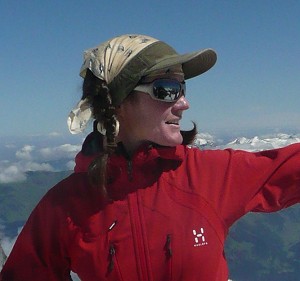
Happy Adventuring!




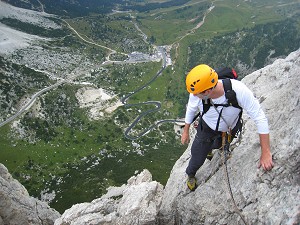
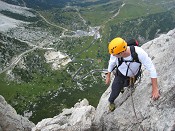





Comments